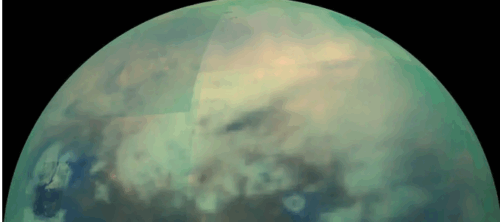2025-04-18 ブラウン大学

This composite image shows an infrared view of Saturn’s moon Titan from NASA’s Cassini spacecraft, acquired during the mission’s “T-114” flyby on Nov. 13, 2015. CreditL NASA
<関連情報>
- https://www.brown.edu/news/2025-04-18/titan
- https://agupubs.onlinelibrary.wiley.com/doi/10.1029/2024JE008737
カッシーニRADARによるタイタンの海岸地形の検出可能性 Detectability of Coastal Landforms on Titan With the Cassini RADAR
S. P. D. Birch, R. V. Palermo, U. G. Schneck, A. Ashton, A. G. Hayes, J. M. Soderblom, W. H. Mitchell, J. T. Perron
Journal of Geophysical Research: Planets Published: 20 March 2025
DOI:https://doi.org/10.1029/2024JE008737
Abstract
Earth’s coastlines serve as the intersection for numerous physical and chemical processes between terrestrial and marine systems. Liquids of different compositions meet, materials eroded from the continents are concentrated in sedimentary deposits, and the diverse planform morphologies of coastal landforms are shaped by erosional and sediment transport processes. Accordingly, coastal landscapes preserve valuable records of processes that govern Earth’s climate, materials, and tectonic history. Applying our understanding from Earth to the coastlines around Titan’s liquid hydrocarbon seas allows us to investigate the climate history of the only other known active hydrological system. The study of Titan’s coastlines, particularly its deltas, however, remains challenging due to the limitations of Cassini Synthetic Aperture Radar (SAR) data and the transparency of Titan’s fluids to microwave radiation. To understand these limitations, we developed a numerical model to simulate Earth’s coastlines as they would appear in Cassini SAR images. We show that multi-kilometer-scale landforms are detectable on Titan, provided there is sufficient contrast between the land surface and seafloor. We revisit Titan and show that many of its large coastal rivers do not terminate in deltas, in contrast to Earth. Additionally, we uncover submerged features on Titan’s seafloors, suggesting sea-level cycling and/or active sub-aqueous flow. We propose preliminary hypotheses to explain the presence or absence of various coastal landforms on Titan, offering directions for future investigations into Titan’s climate and materials. Moreover, we emphasize the opportunities and benefits a superior imaging system at Titan could provide to both Titan science and studies of Earth’s changing coasts.
Key Points
- Many coastal landforms like those on Earth should be detectable on Titan in Cassini Synthetic Aperture Radar (SAR) image data
- Titan’s fluids are transparent to Cassini SAR, which hinders landform characterization but highlights submerged pits and river valleys
- We confirm that the apparent scarcity of observable river deltas is indeed due to their scarcity and not Cassini’s inability to observe them
Plain Language Summary
Earth’s coastlines are fascinating places where liquids mix and materials are shaped into distinct landforms like river deltas, which hold valuable clues about Earth’s climate and tectonic history. Similar active coastlines exist on Titan, Saturn’s moon where liquid hydrocarbons take the place of water. However, studying Titan’s coastlines, especially river deltas, is challenging due to limited imaging data and the unknown nature of its materials. To overcome these challenges, we developed a model that simulates Earth’s coastlines as if seen by the Cassini spacecraft. We discovered that large landforms can be detected on Titan with the right contrasts. We then returned to Titan and re-mapped its coastlines. Surprisingly, we found that many of Titan’s rivers do not end in deltas, unlike on Earth where many large rivers host river deltas. We also found submerged features on Titan’s seafloors that suggest changing sea level and/or active flows under the sea surface. Our proposed hypotheses can shed light on Titan’s climate history and pave the way for future research. We also discuss how a more advanced imaging system could unlock even greater insights into Titan’s landscapes and even benefit our understanding of Earth’s changing coasts.



